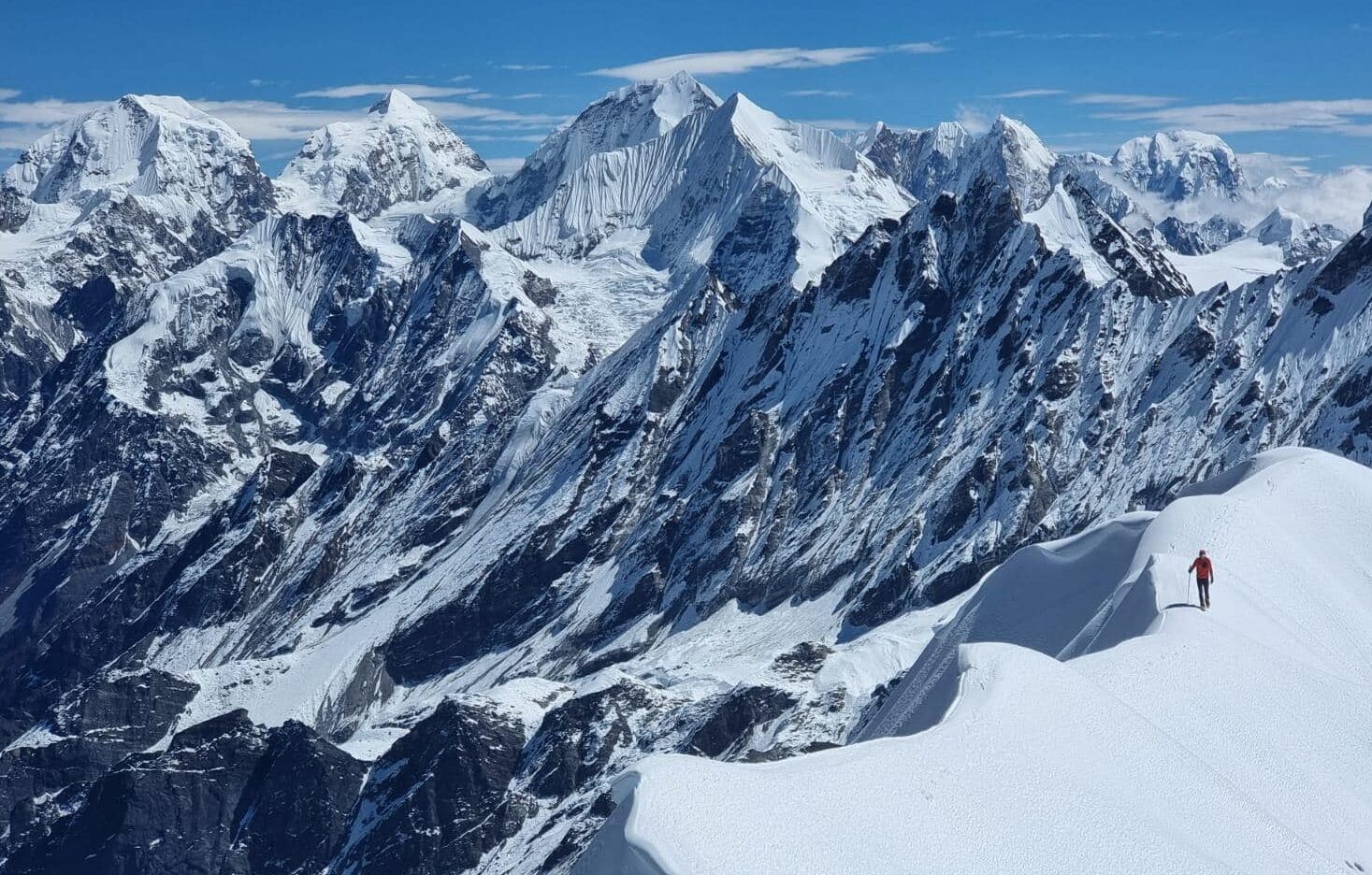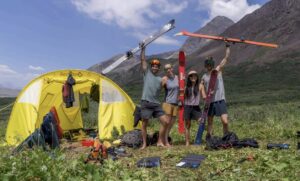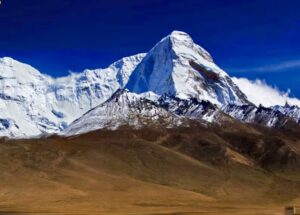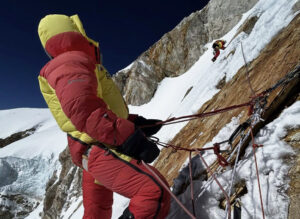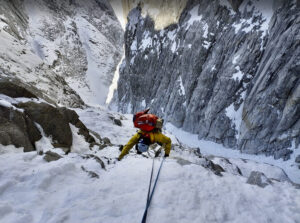Last week, an unidentified pair of climbers secured a permit to climb Ghenye Liru, a 6,571m peak in Nepal’s Langtang region with only one recorded ascent.
This year, it has been harder than ever to get information on climbs in the Himalaya. Among other legwork, we carefully check permit lists shared by Nepal’s Department of Tourism — always at least a week old — for peaks over 6,000m. In the most recent list, there is an entry for a two-man team that paid $800 to climb Ghenye Liru, an aesthetic peak also known as Langtang II.
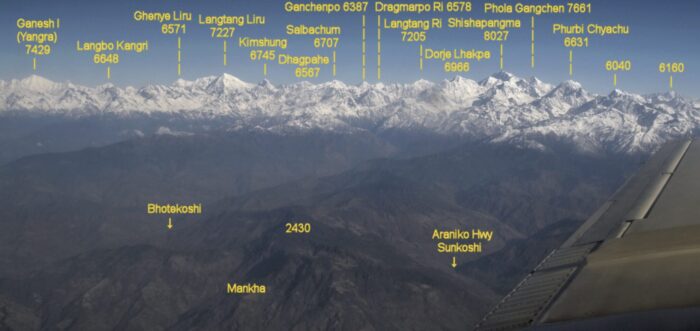
The main summits of the Langtang and Yugal ranges from the air. Photo: Allardteraa.nl
Ghenye Liru has been climbed only once, by Peter Taylor (born in the UK and resident in Australia) and Nepalese climbers Pasang Phutar and Pasang Sherpa, according to The Himalayan Database. Digging around, we discovered a remarkable story of adventure.
A Himalayan newbie
Peter Taylor wanted to climb a peak over 22,000ft (6,700m) in the Himalaya but had no idea which one or where, as he had never been to Nepal. He would have six weeks off between jobs while he moved from Brazil to the Australian Outback.
Taylor went to New Zealand for some last-minute winter training. There, a guide recommended Bill Tilman’s book about Langtang, the closest range to Kathmandu. As a result, Taylor exchanged letters with officials in Nepal, and they finally permitted him to climb a 6,571m peak. Later, he discovered this was Langtang II/Ghenye Liru.
“A couple of Sherpas would come with me, since I had no climbing companions,” Taylor wrote for The Himalayan Club. “I had tried to enlist climbers from New Zealand and Canada, but without luck. It seemed that for the 1963 season, just about everybody I knew had a plan of his own.”
Taylor arrived in Kathmandu, only to learn that customs back in Calcutta had impounded most of his equipment. Taylor had to travel back to the Indian city to solve the issue. By the time he returned, it was already May 18, and the monsoon was around the corner. Around this time, he learned that Ghenye Liru had never been climbed, and no one knew anything definite about an approach route from the west.
He managed to gather a local team of porters and base camp crew, and employed Pasang Phutar and Paang Sherpa as high-altitude porters. Graham Homan, a 27-year-old former Royal Air Force officer whom Taylor had met by chance in Kathmandu, joined him as base camp manager.
“Attempt at summit in the first week of June or not at all,” Taylor wrote before leaving Kathmandu.
Taylor also told his team that it would be a Nepalese expedition and only carry Nepal’s flag to put on top of the peak, should they succeed.
Race against the monsoon
The team reached base camp on May 23. Taylor wrote:
I now had a decision to make: whether to spend time in recce [reconnaissance] and acclimatization and hope for a late monsoon climb or go ahead in an all-out attempt for the top as soon as possible. I decided to go as high as possible right away and take a chance on the effects of altitude.
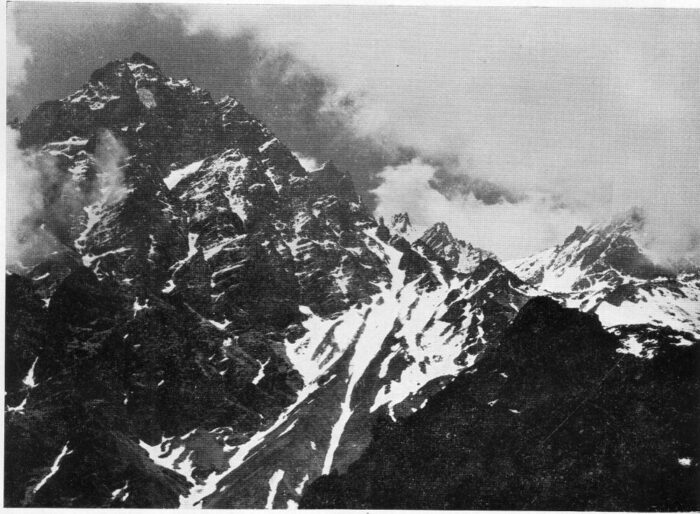
The imposing west face of Liru, photographed by Taylor in 1963. Photo: The Himalayan Club
To complicate matters, the terrain on the west face proved too rough to climb. Taylor used the next day to walk around the peak and check the opposite face. He saw a network of couloirs and steep ridges that disappeared in low clouds. Without knowing the terrain above, he took a chance and departed with the Sherpas on May 25.
They were mid-way up a couloir when a snowstorm broke, forcing the three men to improvise a bivouac at 5,640m. Fortunately, the next morning was clear, and Taylor kicked steps into the firm snow to the top of the couloir. Beyond, there was a plateau with two frozen ponds where the team set up their second bivy, at the foot of the east face.
The following day, the climbers progressed in fog. Eventually, they called it a day, unaware they were at 6,400m.
“Had I known that we were so near the top, I would have dumped everything and gone on. It was only 11:45 am, but I had no idea where we were. I had caught a glimpse of a rather exposed-looking snow ridge higher up. I didn’t feel up to tackling it,” Taylor wrote.
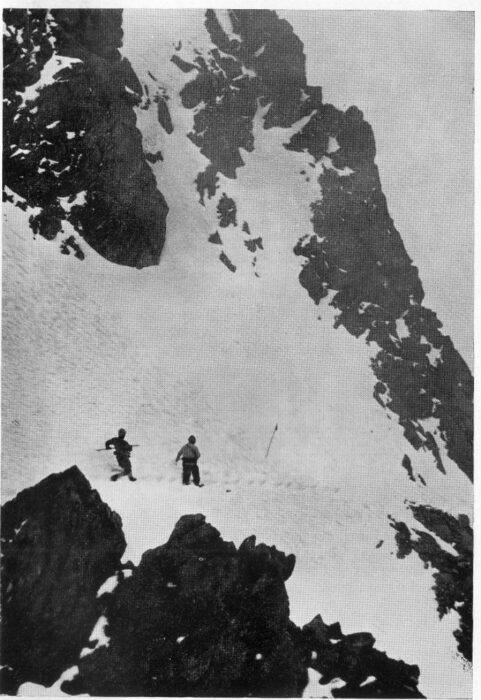
The expedition porters traverse a snow slope. Photo: P. Taylor/The Himalayan Club
Taylor settled in for the night, but couldn’t shake his altitude-related cough. He took some penicillin tablets, only to learn he was allergic when his face swelled. Still, he set off toward the summit the following day, feeling better once he was up and moving.
The team reached the top in foggy weather, took some photos, and returned, first to Camp 2 and then to base camp.
Back in camp, the team’s mail-runner brought news from Kathmandu: an American expedition had succeeded on Everest. Outside the tent, rain poured; the monsoon had arrived.
Meeting the Everest Americans
Taylor dispatched the mail runner with a letter to an American journalist based in Kathmandu, who Reuters had assigned to cover the Everest expedition. The journalist’s name was Elizabeth Hawley.
Hawley kept Taylor’s letter as part of her massive archive of mountaineering expeditions that would eventually give shape to The Himalayan Database.
The Americans on Everest were the members of Norman Dyhrenfurth’s expedition. On May 1, Jim Whittaker became the first American to summit Everest, assisted by Sherpa Nawang Gombu. Then, on May 22, Tom Hornbein and Willi Unsoeld established a new route on Everest via the West Ridge. After bivouacking at 8,500m, they came down the South Side, thus completing the first traverse of Everest.
The final paragraph in Taylor’s diary reads as follows:
We arrived back in Kathmandu on June 6, three days before the Americans got back from Everest. A chance meeting with Colonel Wylie in the Hotel Royal led to an invitation to lunch at his house near the British Embassy. Over a Scotch and soda, I recounted a few of my experiences in the Langtang and elsewhere. ‘How long were you away on your climb ?’ ‘Nineteen days.’ ‘I say, that was a quick one!’ And conversation drifted to other climbs, other places, other men.
Current team unknown
We don’t know who is following in Taylor’s footprints, nor do we know whether they intend to repeat his route or open a new one. Hopefully, we will know more when the team returns.
Ghenye Liru is located in the Langtang Himal, west-southwest of the best-known peak of the range, the difficult Langtang Lirung. The Himalayan Database only registers Taylor’s climb in 1963, but it is unclear if anyone has climbed it unofficially. After the first ascent, the peak was closed to foreigners and only reopened in 2002.
